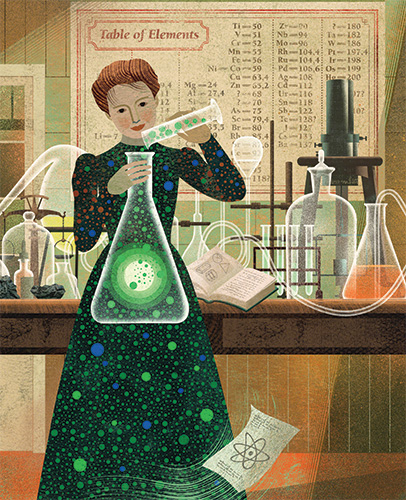
Marie Curie was the first woman to win a Nobel Prize — and the only woman to win two of them — discovered polonium and radium, championed the use of radiation in medicine, and fundamentally changed our understanding of radioactivity and cancer treatment. Those achievements are how the world knows Marie Curie (1867-1934). But the groundbreaking scientist was also a profoundly devoted sister. According to the latest book by Linda Elovitz Marshall ’71, Sisters in Science: Marie Curie, Bronia Dłuska, and the Atomic Power of Sisterhood, that relationship made all the difference.
Marshall, now 73, didn’t even start thinking about writing children’s literature until she was approaching 60. And that was after raising four children — and a flock of sheep — developing and licensing a product called the Pet Husband, and surviving a bout with cancer.
The award-winning author, who has close to two dozen books to her credit and a legion of devoted readers, spoke with us about the unusual path that led her to write about Curie’s rare, unbreakable bond with her sister Bronia.
Did you come to Barnard to study to be a writer?
Oh, no [laughs]. In fact, any inklings that I had about becoming an author faded when I took one of the freshman seminars in the English Department. I took a seminar on fantasy. It was really, really fun. One of my classmates always had her stuff read by the professor, and I never had anything read. That classmate was Mary Gordon!
You were a professional writer before children’s literature. When did you start out?
I taught childhood education and parenting education and consulted for the New York State Department of Education on child health. I went back to graduate school and was studying anthropology and raising four kids and driving everybody everywhere and trying to write a dissertation, and I got diagnosed with breast cancer. I was 38, and essentially I said, “[Expletive] this dissertation.” I grabbed a notebook and began to write from my gut. I shared my poetry with several people, and I started publishing a few things. And during that time, I also contacted Mary Gordon, who was very encouraging.
What started you writing for kids?
As a teenager, I worked at a school for [mentally disabled] children, and I was always interested in early childhood development and psychology. Then I had an opportunity to open a bookstore [in Albany]. Later on, I opened another bookstore.
I had a fabulous time with my bookstores. People would line up at my cash register and tell me their problems, much of which were with husbands who didn’t put toilet seats down or pick up dirty socks. At some point, one of my customers said, “Does anyone remember the Pet Rock?” [It was a short-lived marketing fad in 1975.] And that person said, “What about a pet husband?” And I said, “This is a great idea.”
I took one of my husband’s socks and drew a face on it [laughs] and had it trademarked. Someone said I should write a book about it. I decided to license it because I didn’t want to go into manufacturing. The last thing I needed was a warehouse full of pet husbands! So I started making up other characters, and I said, “Maybe I should write a story.”
And that started your career as a children’s author?
Well, then I took the idea of the other characters and some classes about how to write for children. Then my daughter said, “Mom, you can do this.”
Why did you choose to write about Marie Curie and her sister?
A friend had just written about Marie Curie and her sister. I thought it was fascinating, and I said, “Let’s turn this into a picture book.” What’s really not known about the sisters is that they had a pact. They would support each other. [When Marie became depressed], it was Bronia who told her to get her act together, reminding her, “You want to study science, right?”
What do you hope to bring out about science and sisterhood with this book?
There are many takeaways from Sisters in Science. One takeaway is a gentle introduction to the science of chemistry; another is learning about the discovery of radiation and radioactivity; a third is about hard work and perseverance; a fourth is about doing good for others; and a fifth is about the importance of helping others achieve their goals.
There may be others, too. I hope readers learn that, no matter how famous someone is, other people probably helped them along the way. Everyone needs help from someone: friends, family, teachers, and mentors.
Any advice to Barnard students who aspire to be writers?
Writing is hard work. Don’t get discouraged. Try to write something every day … even if it’s just a few words. Writing is a “muscle” that needs to be exercised. Keep a notebook, or use the “notes” section on your phone, and jot down ideas. Try to find one idea a day. Keep reading. Keep learning. You never know where ideas will come from. Most importantly, have fun! As for me … I didn’t start writing for kids until I was 60! It’s never too late.
Photo by Tom Stoelker. Illustrations copyright © 2023 by Anna and Elena Balbusso.






